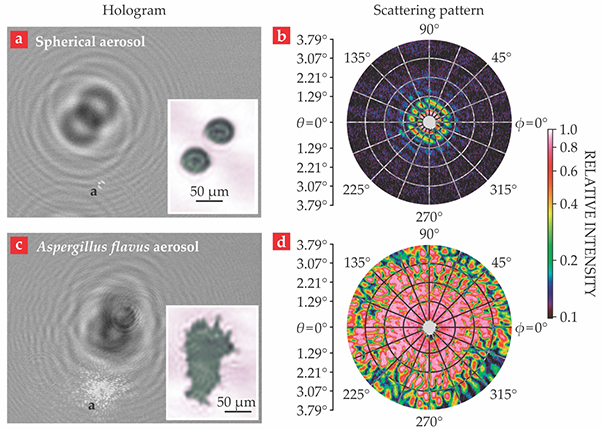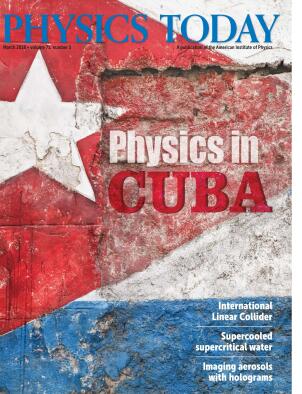Imaging aerosols with digital holography
DOI: 10.1063/PT.3.3879
Aerosols—suspensions of liquid drops or solid particles in gas—can be human made or natural. Atmospheric aerosols include water droplets, wind-blown mineral dust, pollen and other biological particles, and carbonaceous particles such as soot. The diversity of particle shapes and sizes is vast. Some drops are nearly spherical, but bits of mineral dust have irregular shapes. Some aerosols are molecular in scale; others are hundreds of micrometers in size.
Atmospheric particles absorb and scatter sunlight and thereby affect the balance between incoming and outgoing radiative energy in the Earth–atmosphere system. Aerosols are but one of several components affecting that energy balance; greenhouse gases and ozone, for example, are other, more commonly known substances. The quantitative measure for how a given material influences the energy balance is called radiative forcing. Positive forcing values indicate a heating of the system, whereas negative values indicate cooling. For greenhouse gases, the forcing value is well understood and unambiguously positive. For aerosols, the forcing value is estimated to be negative and comparable in magnitude to most other atmospheric components. But less is known about the aerosols; for mineral dust in particular, the uncertainty in the forcing value is greater than the value itself. And aerosols can affect Earth’s energy balance in more subtle ways —for example, they influence cloud formation.
To simulate how the global climate will respond to temporal and spatial variations in physical parameters such as radiative forcing, physicists rely on general circulation models—physical models based on thermodynamics and fluid dynamics. One factor that affects the accuracy of a global circulation model is the accuracy of the forcing values that go into it. Thus it is important to better understand how particles absorb and scatter light and, in particular, to discover how those radiative effects depend on the diverse morphology and size of the particles. In this Quick Study, we discuss what we know best, our own work, which was conducted with Stephen Holler at Fordham University. Other groups doing related work include those led by Hans Kreuzer at Dalhousie University and by Raymond Shaw at the Michigan Technological University.
Sidestepping the inverse problem
James Clerk Maxwell’s theory of electrodynamics, which describes how a particle scatters light, is a powerful tool for modeling aerosol forcing. But before that tool can be put to use, one needs to know the detailed morphology and composition of the scattering particle. Unfortunately, for atmospheric mineral dust in particular, little is known about morphology.
Collecting mineral dust or other particles for study can distort or even destroy the particles’ shapes, so the material is best studied in a contact-free manner. Optical light-scattering methods are thus commonly used for characterization. In short, a laser beam illuminates freely flowing particles, and a CCD sensor records the angular pattern of scattered-light intensity. In principle, interpreting the scattering pattern, guided by Maxwell’s theory, should yield useful information about the scattering particle. For example, if the particle is spherical, the pattern produced has a simple angular form and can be readily analyzed to determine the particle’s size. However, if a particle is nonspherical, the scattering pattern can become extremely complicated, and any inference of particle shape or size is thus questionable. The difficulty of translating a scattering pattern into information about a particle is known as the inverse problem.
We get around the inverse problem by means of digital holography, a technique that uses pulsed-laser illumination to image freely flowing particles. As shown in figure
Figure 1.

To form a digital hologram of a particle, (a) the interference pattern of scattered and unscattered light is registered by a CCD sensor. (b) Computer-assisted analysis of the hologram renders a silhouette-like image of the irregularly shaped particle.

Incorporating the scattering pattern
Holographic images provide important information about particle shape and size. In fact, they can furnish an estimate of a particle’s extinction cross section, a measure of its total absorption and scattering. However, it is still desirable to know a particle’s scattering pattern: Integrating the pattern over angle gives the full extent to which a particle scatters light; that information, in combination with an extinction cross section, can be used to estimate the particle’s radiative forcing. Scattering patterns and digital holographs together, we hope, will allow us to assist modelers by relating forcing values to particle morphology.
To simultaneously obtain the digital hologram and scattering pattern for a particle, we add a second light source and use a color sensor. That is, we illuminate the particle with two overlapping laser beams of different wavelengths; one red (640 nm wavelength), the other green (526.5 nm wavelength). The red beam—scattered and unscattered—proceeds to the CCD, where the sensor’s red channel records the hologram, as in figure
Figure
Figure 2.

Rather than confront the inverse problem head on, we simultaneously measure a particle’s scattering pattern while imaging it with digital holography. (a) A pair of spherically shaped 50-μm-diameter silicon dioxide particles generated the digital hologram shown here. The insert shows the particle image rendered from the hologram. (b) In this SiO2 scattering pattern, θ denotes the polar, scattering angle and ϕ is the azimuthal angle. Light is incident on the particles from the z-direction, perpendicular to the page. Color gives relative intensity. (c, d) An aerosol particle of the fungus Aspergillus flavus yields a more complex hologram and a much more complex scattering pattern. The features labeled “a” in the holograms are measurement artifacts. They arise because green light, which is resolved in the sensor’s green channel to give the scattering pattern, can leak into the sensor’s red, hologram-determining channel.

In future work it may be possible to use digital holography to address the important problem of accurately describing the morphology and size of mineral dust in the atmosphere. Kansas State University, where two of us (Berg and Kemppinen) are located, is developing an instrument that implements digital holographic imaging of single particles from aboard an unmanned aerial vehicle and that will be able to study mineral dust and plant-derived aerosols in agricultural settings. The goal is to assemble the first in situ statistical description of mineral dust particle morphology in a real-world environment.
This work is supported by NSF award 1665456 and US Army Research office award W911NF-15-0549.
References
► T. Kreis, Handbook of Holographic Interferometry: Optical and Digital Methods, Wiley-VCH (2005).
► M. J. Berg, Y. W. Heinson, O. Kemppinen, S. Holler, “Solving the inverse problem for coarse-mode aerosol particle morphology with digital holography,” Sci. Rep. 7, 9400 (2017). https://doi.org/10.1038/s41598-017-09957-w
► M. J. Berg, N. R. Subedi, P. A. Anderson, “Measuring extinction with digital holography: Nonspherical particles and experimental validation,” Opt. Lett. 42, 1011 (2017). https://doi.org/10.1364/OL.42.001011
More about the Authors
Matthew J. Berg is an associate professor of physics at Kansas State University in Manhattan, Yuli W. Heinson is a postdoctoral research fellow at Washington University in St Louis, in Missouri, and Osku Kemppinen is a research assistant professor at Kansas State.



